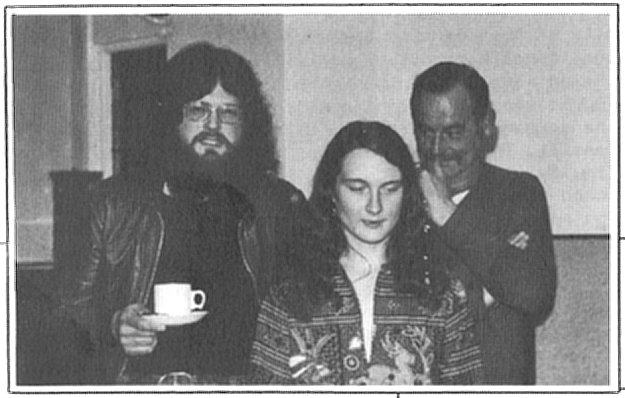
3. (Left to right): Nigel Pennick, Prudence Jones and Mike Collier, speakers.
Journal of Geomancy vol. 3 no. 2, January 1979
In this Web version, the photos (pp. 42–43) have been rearranged, but not renumbered. – MB, March 2016
{42}

3. (Left to right): Nigel Pennick, Prudence Jones and Mike Collier, speakers.
The Second Cambridge Geomancy Symposium was held at St. Andrew’s Street Hall, St. Andrew’s Street, Cambridge, on the 16th September 1978. The hall, which is correctly orientated north–south with the speaker at the north end, saw talks by Nigel Pennick, Prudence Jones, Mike Collier and Peter Martin. The proceedings began with Prudence Jones on the work of German geomantic researchers of the 1920s and 30s. Often, for convenience, the branch of the subject is called Nazi Geomancy, but this is incorrect, as most, if not all, of the researchers of that period became connected with the National Socialist Party only after its election to power in 1933. Elsewhere in this issue is a translation of German work of the period, by Josef Heinsch, one of the leading lights of that school.
Nigel Pennick spoke on the omphalos–tree–sanctuary connexion, and Mike Collier gave a talk illustrated with slides on his part of Sussex in which he discovered the Stonegate Zodiac. His elephant effigy, upon which’s tusk a real elephant or mammoth’s tusk has been excavated, will be written up soon as an I.G.R. publication, probably an Occasional Paper.
Peter Martin spoke on the paintings of Nicholas Roerich, a Russian mystic author of Shambhala (1930). The colour slides of Roerich’s stunning paintings were received with awe, as most of the members of the audience had never seen any of them before.
Symposia such as the two which have now been held by the I.G.R. at St. Andrew’s Street Hall have proved to be a valuable meeting place for geomants and their fellow-travellers. We hope to hold the Third Cambridge Geomancy Symposium next summer, probably in July or August, so potential speakers and audience – watch this space for announcements!
We would like to thank John Cann of the I.G.R. and Ivan Bunn of the Borderline Science Investigation group for their photographic expertise shown on this page. {43}
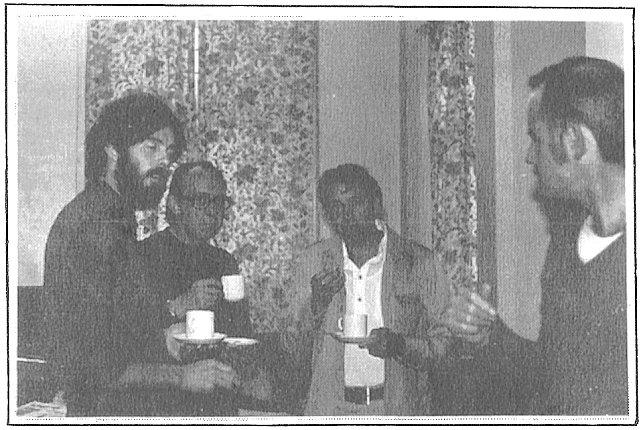
4. (Left to right): Peter Martin (speaker), Ted Ambrose, Bob Cowley (RILKO), Mike Collier.
Russian-born Nicholas Roerich (1874–1947) travelled widely in Central Asia and lived many years in the Kulu valley, northern India. He developed an understanding of the neolithic period, finding evidence of knowledge and culture (cult-ur – cult of light) in contrast to popular notions of Stone Age primitives. Within the beauty of his paintings, much of geomantic interest can be found to support theories regarding the sources and universal character of the knowledge and traditions living through that period. His paintings reveal an understanding of the subtle forms and emanations of humans and their subjectivity to various laws, and indications of escape from planetary bounds. The architecture of Tibetan monastic buildings and chortens, for example, formalizes a working knowledge of planetary laws and spiritual progression in a way comparable with the Gothic tradition in Europe. He also depicted megalithic structures in these regions, parallel in design to those of Europe which he had seen, commenting, for instance, on the similarity of Do-ring, Tibet, to Carnac in Brittany. He makes many references to Shambhala, which may perhaps be understood as an equivalent of the crown chakra, the thousand-petalled lotus, existing in the etheric planes over the wastes of the Gobi desert. And in studying these inspiring paintings comes the realization that in order to receive the knowledge they exude it is necessary to develop an appropriate attitude and vision – as indeed one must for any real experience of the geomantic arts. Then, they become both a source from which one may drink long and deep, and a touchstone and guide on the real journey.
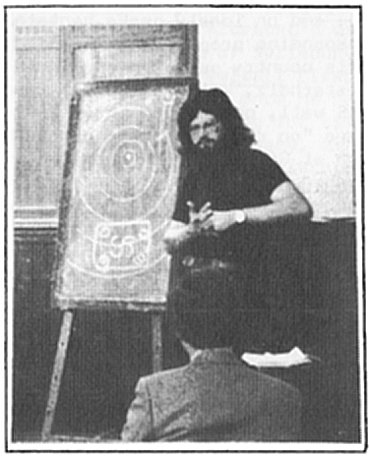
2. Nigel Pennick expounds on a theme of progressive zones of sanctuary at Beverley Minster.
The Omphalos of Delphi, centre of the ancient Greek religious world, has given its name – meaning navel – to any site divined as a most powerful site of sacred energy. The divination of such sites has always been difficult (see my book The Ancient Science of Geomancy – Thames & Hudson, to be published April ’79), and once defined they have been jealously defended against pollution and desecration by the profane and infidel. Surrounding the omphalos, which itself has often been represented as a stone, tree or pole, a progressively diminishing zone of sanctity {44} as one is removed from the proximity of that central omphalos. Dowsers have found spiralling patterns – blind springs – beneath important centres such as the omphalos of Westminster – the tomb of the Saxon king Edward the Confessor, and this tallies with the archetypal image of the world serpent coiling around the central tree of the universe, in Norse religion the serpent (Midgardsorm) Nidhoggr which at once protects and gnaws the tree Yggdrassill. This association of the earth’s energies with the serpent or dragon is worldwide, its connexion with the omphalos being almost always recounted in legend and sacred history.
Saints like Michael and George, who spear the dragon with lance, sword or arrow, are representative of the solar patriarchal religion superseding the diffuse, matriarchal chthonic religion of the earth mother. In place of the undefined numinous qualities surrounding sites, the energies of the holy places are fixed at one place and time in order that their power may be tapped at suitable times, rather than being available at occasional, and possibly inconvenient instances. The fixation of these energies, symbolized by driving the lance or peg through the head of the dragon, was a dangerous process, fraught with risks both to operator and mankind in general. The struggle between saint and dragon symbolizes this difficult task – sometimes accomplished, but often, through miscalculation of the right date, or unsuitability actually failing. In addition, the powers, once fixed at the ceremony of driving the peg, had to be kept in, lest they should depart from their place and be difficult in recapture. Various legends recount this gradual loosening of the hold of the energies at the omphalos. Many a time, the dragon power gets loose, Satan is ‘loosed a little season’ after being bound, the serpents free themselves, the Fenris-Wolf looses its bounds – all represent the escape of earth energies from their former state of fixation.
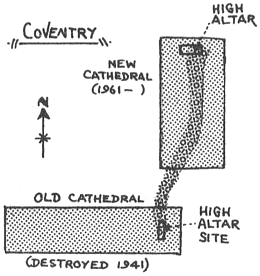
The knowing misorientation of the second cathedral at Coventry may be due to this loosening of earth energies. Of the three modern Anglican cathedrals, Liverpool, Guildford, and Coventry, only the second is orientated in the correct manner – east–west with the altar at the east end. Liverpool is north–south, with the altar at the south (the ‘notional’ east end). Coventry is also north–south, but the notional east is at the north end. The old cathedral was a mediaeval church upgraded to cathedral status in 1914, and, naturally, orientated correctly. In 1941 it was destroyed in a Luftwaffe raid. Strangely, when the war was over, the church authorities decided to rebuild the cathedral not on the ancient site, but to the north and at right angles. My hypothesis is that the violence of the bombs dropped by the German Air Force in 1941 invalidated the omphalos of the church, flipping the energies out of their pre-ordained position and northwards to the site now occupied by Sir Basil Spence’s concrete and glass cathedral, consecrated in 1961. This 1941–1961 twenty year period is paralleled at Guildford, where the cathedral, planned for consecration in 1941, had to wait until 1961 for its ceremony.
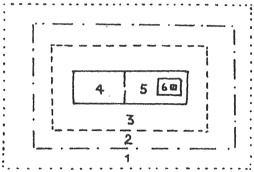
Around modern cathedrals is the standard garth, or precinct, and beyond that the desacralized cosmos. In geomantic times, the sanctity faded gradually, and was not cut off abruptly by a secular guillotine at the gates of the precinct. In old English sanctuary law, this was recognized. Sanctuary towns like Beverley in Yorkshire had 6 degrees of sanctuary, and the penalties levied on those who broke sanctuary varied according to the place in which the transgression occurred. For the first 5, the fines increased accordingly. The last, inner sanctum, was so sacred that transgressors who profaned that place by taking out those who had claimed sanctuary were declared bootless – that is, in the same state as an outlaw, condemned men who could be killed by anyone. The levels of sanctuary – comparable with the hierarchies of heaven and hell – were the outer town (1), the inner town (2), the churchyard (3), the nave of the church itself (4), the chancel beyond the rood screen (5), the presbytery (6), and finally the Frithstool, in which the person seeking sanctuary would sit to avoid prosecution. It is possible that the stages of sanctity may in some way be related to the Ptolemaic cosmology with the earth in the centre and the planets around it – a perfect analogy for an omphalos representing the centre not only of the locality nor even of the earth, but of the entire universe.
{45}
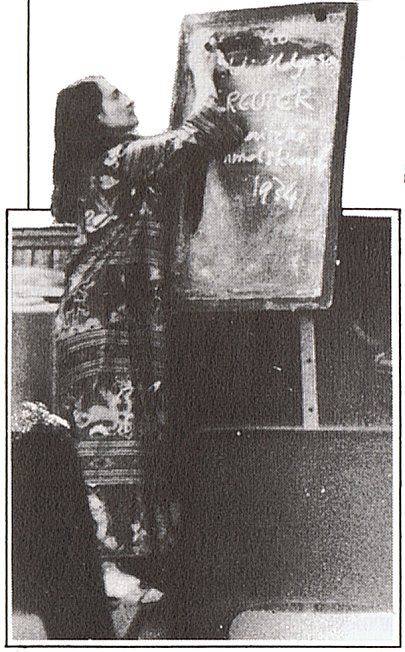
1. Prudence Jones lectures on the leading lights of German geomantic research.
There was a substantial body of geomantic research going on in Germany before and during the 2nd World War. It is little known in the English-speaking world today, partly, one assumes, because of its political associations and partly because there does not seem to have been either knowledge or collaboration among English-speaking geomancers of the time.
A major worker in the field was Wilhelm Teudt. He died in 1937 but not before he had engaged in ten years of public controversy over the supposed archaeoastronomical significance of a historic part of Lower Saxony/Westphalia: the Teutoburg Forest. It was in this area that Arminius (Hermann), the Roman-trained German leader, proved himself to be no quisling but turned round and defeated the Romans by their own tactics. In 21 Christian Era the battle of the Teutoburg was won, and the Romans did not venture near German lands for the next 400 years.
The area is something of a national shrine, rather like our Stonehenge in its mixture of fringe cults and official sanction. The Externsteine near Horn are one of many antiquarian sites in the area. They are three enormous rocks, about sixty feet high from the photographs, originally natural but extensively altered by human artifice. Teudt’s claim was that the Externsteine were in fact an astronomical observatory, of cultic significance (ein Gestirnheiligtum) rather than purely scientific (eine Sternwarte), although he points out that this duality cannot really be attributed to such an integrated culture as ancient Germania must have been.
His evidence consists of the solar and lunar sighting lines from the so-called “sacellum” which he claims was only turned into a chapel after Charles the Great conquered the Germans and destroyed this culture. There is archaeological evidence of stoneworking to change the alignment of the sacellum. Secondly, the carving at the foot of one of the rocks, depicting Christ’s descent from the cross, contains a device which Teudt equates with a bowed Irminsul, the holy tree or totem (“sul” gives modern “Säule”, pillar) of the ancient Germans. Teudt interprets Charles generally as the Roman conqueror who achieved by cultic means what the imperial Romans could never achieve militarily: the conquest and humiliation of the Germanic people.
Also in the area is a hunting lodge, Haus Gierke. Teudt’s claim is that this is built on the site of an ancient observatory whose significant bearings are marked out by the earthworks (“Wälle”) aligned on 7 major stars at their positions 600 years before the Christian Era (also 1500 years before, but Teudt discounts this date). Two astronomers from the Potsdam observatory verified Teudt’s calculations, and statistical analysis proved the results significant, so it is claimed by Teudt in the journals. We have here an almost exact parallel of the controversy over Tim O’Brien’s astroarchaeology on Wandlebury hillfort. (Continuing elsewhere in this issue – ed.)
Teudt’s third postulate, the most topical for us, is the existence of “holy lines” linking significant sites in the area. A major fort will have at least one orientation marker in the shape of so-called watch-towers along the N–S and E–W axes. Teudt stresses the importance of magnetic north for the ancient Germans. Otto Sigfrid Reuter, in his book Germanic Astronomy (Germanische Himmelskunde, 1935, not translated, out of print), did more work on the same theme in Iceland. “Holy lines” became a catch phrase as “ley lines” is nowadays. Teudt lists over 40 of these lines in his book Germanic Sanctuaries (Germanische Heiligtümer, 1932, not translated, out of print). And when maps are available the lines can be checked. Luckily, there is a NATO presence in the area now and so the Ordnance Survey will have been busy, if we can only get hold of its results.
Teudt’s seminal work appears in Mannus 1927–8 and further contributions and discussion figure in that Journal and in Germanien and Hagal from then on until the collapse of the Third Reich in 1945. At the Institute of Geomantic Research we are at work retrieving and evaluating the results in order to make available a body of findings that is as relevant to our political culture as it was to that of Germany in the 1930s.
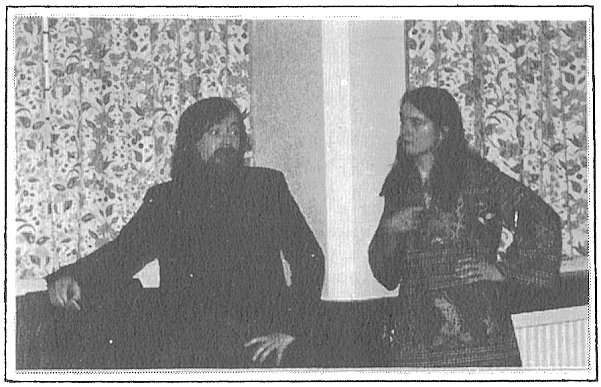
5. Paul Devereux (The Ley Hunter) discusses geomancy with Prudence Jones.
Photocredits 1 & 2 John Cann 3, 4, 5, Ivan Bunn